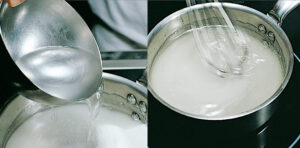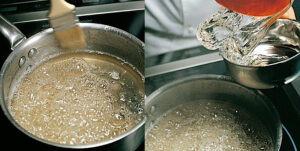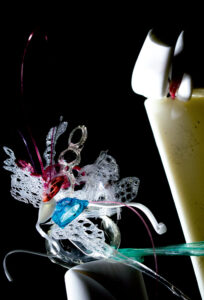Categories Pastry Chef Articles
Most common types of sugar in pastry by Paco Torreblanca
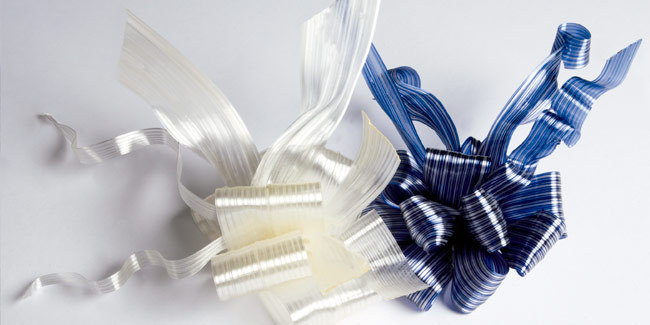
“Paco Torreblanca”, recognized as the Best Pastry Book in the World in the year of its launch and the Euskadi Special Prize for the Best Gastronomic Publication, has become a contemporary pastry classic.
Available in a bilingual version (Spanish & English) in our Books For Chefs online bookstore, the book was originally published in 2003 and is now in its fourth edition. It contains 500 illustrations, 32 step-by-step creations, more than a hundred cakes, restaurant desserts, and bonbons, new and surprising techniques, artistic pieces, and decorative elements.
One of its chapters is dedicated to sugars, essential ingredients in pastry not only for their sweetening power, but also due to their multiple technical properties.
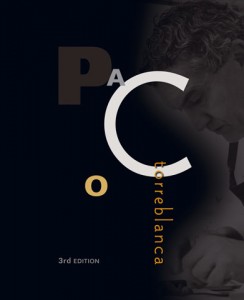
Sugar, the first pleasure
If chocolate is usually called the “king” of patisserie, I am not quite sure what we should call sugar, since it really is the ingredient on which all patisserie concepts are based. If we think about pleasure from flavor, most people will think about candy, dessert or something sweet, because the sense of sweetness has been retained in our memory of tastes since the earliest human origins. Sweet things, sugary things and sugar itself have always been present in nature. Fruit and honey are the best examples, but there are many other edible elements that man received as a first pleasure. Let us imagine how incredible the discovery of honey must have been, and how quickly we were able to work with it, use it and transform it.
Honey’s virtues have been debated by poets – from the perspective of pleasure associated with love and the beauty of a loved one – and by wise men and doctors – from the source of health – since ancient times. From the world of gastronomy we receive recipes and common uses that come from Ancient Egypt and Classical Greece, from its use as a wine and liquor sweetener and a preservative, to its use in meat dishes and its starring role in desserts and candies.
The world of sugar has evolved and, even though sucrose obtained from sugarcane, beets and honey are still the most commonly used types of sugar, technological innovation has produced a wide array of sweeteners that have contributed to making even richer the world of patisserie and ice-cream.

The most common types of sugar used in pastry
Saccharides
- Refined grain sugar / Icing sugar / Impalpable icing sugar / Lump sugar / Semolina sugar / Granulated sugar / Crystallized sugar / Colored crystallized sugar / Candy sugar / Sugarloaf / Brown sugar / Raw beet sugar / whole cane sugar. These are the sweeteners par excellence in confectionery in all their presentations. They act as crystallizers, are antioxidants in doughs and biscuits, improve textures and are good preservatives. They come from sugar cane processed in different ways depending on the type and are made up of 50% fructose and sucrose molecules. With the exception of brown sugar, which is a semi-finished product obtained directly from the dark syrups of the cane sugar refining process, and raw beet sugar with crystals covered by a layer of molasses that is later refined. P.O.D. 100 – P.A.C. 100
- Muscovado sugar. It comes from whole cane sugar by a process in which a dark syrup is obtained that is allowed to crystallize. It can be used in biscuits, creams, ice creams, etc. It has a characteristic and pronounced flavor similar to liquorice.
Other Sugars
- Invert sugar. Unctuous and odorless white paste, or colorless liquid obtained by inverting sucrose by heating it with water, an acid and sodium bicarbonate (hydrolysis). It is used in biscuits, truffles, ganaches, ice creams and creams with a high content of dry extracts. It enhances aromas, improves dough structure, prevents frozen products from drying out, reduces crystallization, prolongs the shelf life of chocolates and lowers the freezing point of ice cream. P.O.D. 130 – P.A.C. 190
- Honey. It is a natural invert sugar. Dark brown to amber in color, it is produced by bees and contains fructose, glucose, and water. It is used in biscuits, truffles, ganaches, ice creams, and creams with a high content of dry extracts. It enhances aromas, improves the structure of doughs, prevents frozen products from drying out, reduces crystallization, prolongs the shelf life of chocolates, lowers the freezing point of ice creams and, in addition, adds its characteristic flavor to preparations. P.O.D. 130 – P.A.C. 190
- Fructose. Fine white crystallized powder. It is the sugar contained in fruits and vegetables obtained by hydrolysis. It is used in ice cream and sorbets. Increases the melting time of ice creams, decreases the freezing time and prevents the crystallization of ice creams and sorbets. P.O.D. 170 – P.A.C. 190
- Glucose. In colorless viscous syrup dehydrated powder. It is obtained from corn, sweet potato, rice or potato starches. It is used in biscuits, ganaches, ice creams, preserves and candied fruits. It prevents the crystallization of cooked sugar, increases the freezing time of ice creams and delays their thawing and crystallization, prevents preparations from drying out, adds moisture to biscuits and unctuousness to ganaches and ice creams. P.O.D. +-40 – P.A.C. 73
- Atomized glucose. In whitish viscous syrup or dehydrated powder. It is obtained from a partial hydrolytic decomposition. It is used in biscuits, ganaches, ice creams, preserves and candied fruits. It prevents the crystallization of cooked sugar, increases the freezing time of ice creams and delays their thawing and crystallization, prevents preparations from drying out, adds moisture to biscuits and unctuousness to ganaches and ice creams. P.O.D. +-40 – P.A.C. 73
- Dextrose. Fine white powder that dissolves well in water and is extracted from corn starch. It is mainly used in ice cream. It improves the texture of ice cream, enhances aroma and flavor, provides freshness and reduces the freezing time of ice cream. P.O.D. 75 – P.A.C. 190
- Lactose. Milk sugar in the form of white crystallized powder. It is used in soft candies, almond pastries, fondants, and pralines. Little sweetening power and fixes the aromas. P.O.D. 16
- Isomalt sugar. Glossy powder similar to icing sugar that is obtained by hydrolysis of sugar and subsequent hydrogenation. It is mainly used in the ice cream and chewing gum manufacturing industry. In confectionery, combined with other sugars, it is used in ice creams, creams, candies, and crocants. Perfect for artistic sugar work. It is not affected by humidity, it melts quickly without the need to add water, it does not take color when heated, it does not melt well in the mouth and it is suitable for diabetics. P.O.D. 50
Sugar in gastronomy
In general terms, sugar enhances the flavor of most foods. Sugar improves the elasticity of baked goods and fermented dough and makes the final product spongier, lighter and drier. It also prevents the air that gets into the dough during the mixing process from escaping during baking. It is an excellent preservative, which is why it is used in jam, marmalade and gelatin. It also prevents crystallization in these products.
If it is used in salsas that contain flour, it prevents the sauce from getting lumpy. It softens meats, and as such is used in the preparation of some cured products. Sugar’s use in tomato sauces to enhance flavor and reduce acidity is more commonly known. The contrasts of sweet and salty, sweet and bitter, and sweet and acidic are becoming more and more common both in cooking and dessert preparation. The resulting flavors are quite interesting.
Artistic sugar
In the book Paco Torreblanca, the chef talks about ingredients and techniques to use in the creation of decorative elements in caramelized sugar and that open up an infinite range of aesthetic possibilities with which to accompany cakes and desserts.
Sugar is the main ingredient in many decorative elements that can be used in patisserie. When discussing decoration we must not fall into the trap of thinking only about grandiose presentations that can be displayed in a store window or grand buffets, but rather a series of small decorative pastillage details, crystallized sugar, poured or pulled sugar, caramels, etc. These are some of the components, together with chocolate decorations, enrich and adorn our cakes and desserts.
This is a subject that he also deals with in-depth in his book, Colección, where he reviews the main types of decorative sugar and its cooking.
